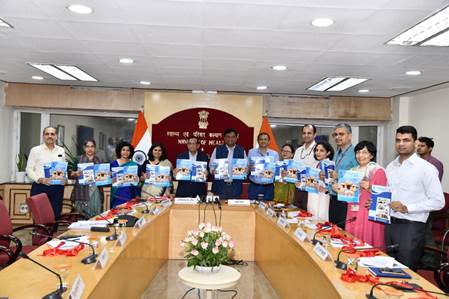Context:
Recently, the Union Ministry of Health and Family Welfare published the National Health Account (NHA) estimates for the fiscal years 2020-21 and 2021-22.
More on the News:
- These reports are the eighth and ninth editions of the NHA series, which provides a comprehensive view of the country’s healthcare expenditure.
- This release highlights significant trends such as an increase in India’s public healthcare spending, and a decline in out-of-pocket expenses, demonstrating the government’s commitment to improving public healthcare accessibility and ensuring financial protection for citizens.
Key Findings of NHA Estimates
Rising Government Health Expenditure (GHE):

- The Government Health Expenditure (GHE) in GDP term has significantly increased, rising from 1.13% of GDP in 2014-15 to 1.84% in 2021-22.
- In terms of share in the General Government Expenditure (GGE), it has increased from 3.94% in 2014-15 to 6.12% in 2021- 22.
- In per capita terms, GHE has tripled, from Rs. 1,108 in 2014-15 to Rs. 3,169 in 2021-22.
- The Government spending on health between 2019-20 and 2020-21 increased by 16.6%

- This indicates a proactive government strategy to bolster healthcare services, especially during the challenges posed by the COVID-19 pandemic.
The decline in Out-of-Pocket Expenditure (OOPE): The share of OOPE in total health expenditure has decreased from 62.6% in 2014-15 to 39.4% in 2021-22. This decline is attributed to increased public health spending, enhancing access and reducing the financial strain on families seeking medical care.

Increased Share of Government Health Expenditure in Total Health Expenditure: The government’s share in the Total Health Expenditure (THE) increased from 29% in 2014-15 to 48% in 2021-22.
Growth in Social Security Expenditure (SSE) on Health: The increase in Social Security Expenditure (SSE) on health from 5.7% in 2014-15 to 8.7% in 2021-22 showcases a robust mechanism aimed at minimizing financial hardships for individuals accessing essential health services.
- This increase in social security has a direct impact on reducing out-of-pocket expenditures.
- The share of SSE on health includes government-funded health insurance, medical reimbursements to government employees, and social health insurance programs.
Implications of Increased Government Spending on Healthcare
- Reduction of Financial Hardships: Declining Out-of-Pocket Expenditure (OOPE) shows the government’s commitment to financial protection. Increased public healthcare spending reduces the burden on households, making healthcare more accessible for low and middle-income families.
- Strengthening Public Healthcare Services: Rising Government Health Expenditure (GHE) has improved healthcare infrastructure, leading to better-equipped hospitals and expanded vaccination programs.
- Progress Towards Universal Health Coverage: Increased healthcare spending supports Universal Health Coverage (UHC) goals by expanding public health programs and ensuring affordable healthcare access.
- Response to COVID-19 Pandemic: Healthcare spending surge in 2020-22 strengthened infrastructure for COVID-19 response, supporting testing, treatment, and vaccination programs.

